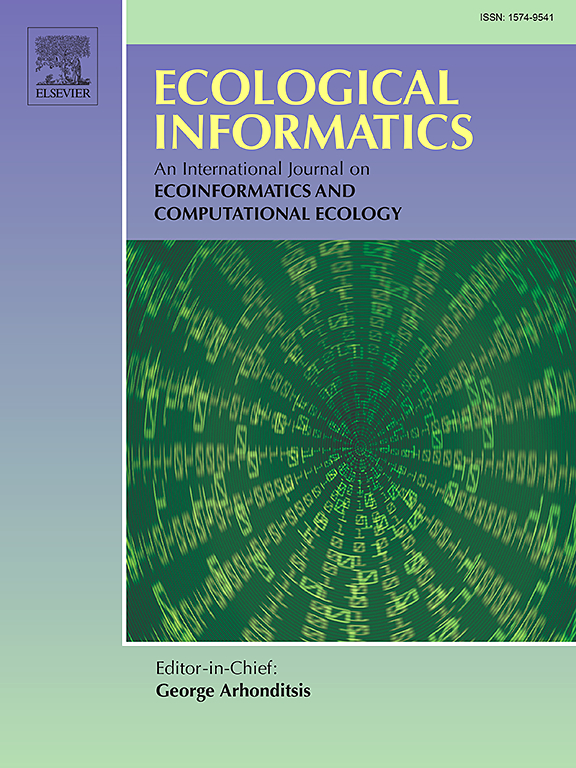Innovative soil classification approach for achieving global biodiversity framework utilizing integrated data fusion of EMIT and multispectral satellite observations: Case study of Imam Turki bin Abdullah Royal Reserve, Kingdom of Saudi Arabia
IF 5.8
2区 环境科学与生态学
Q1 ECOLOGY
引用次数: 0
Abstract
Soil classification is essential for sustainable land management, ecological conservation, and combating desertification, particularly in arid and semi-arid regions. This study integrates hyperspectral data from the Earth Surface Mineral Dust Source Investigation (EMIT) and multispectral imagery from Sentinel-2 to achieve accurate soil classification for the Imam Turki bin Abdullah Royal Reserve (ITBA) in Saudi Arabia. Using advanced Machine Learning (ML) techniques, including Extreme Gradient Boosting (XGBoost), the study highlights the power of data fusion in addressing the limitations of standalone remote sensing methods. The integration of hyperspectral and multispectral data combines the spectral richness of hyperspectral imaging with the spatial resolution of multispectral data, providing detailed insights into the region's heterogeneous soil types. The Gram-Schmidt fusion technique enhanced spatial resolution, enabling precise identification of inter-dune soils, linear dunes, and rocky outcrops. The resulting soil classification map achieved an accuracy of 93 %, outperforming traditional methods and existing maps. Inter-dune soils, characterized by their loamy-skeletal texture and superior moisture retention, were identified as critical for supporting vegetation and afforestation efforts. This research also developed a suitability map for afforestation by incorporating weighted overlays of soil fertility, moisture retention, and vegetation indices. These findings directly contribute to global biodiversity priorities, supporting the Convention on Biological Diversity (CBD) and the associated Global Biodiversity Framework (GBF) targets such as reducing biodiversity loss (Target 1), restoring ecosystems effectively (Target 2), minimizing the impacts of climate change (Target 8), and enhancing sustainable agriculture (Target 10). Furthermore, the study utilizes these advancements in addressing land degradation and achieving the United Nations Sustainable Development Goals (SDGs), including Zero Hunger (SDG 2), Climate Action (SDG 13), and Life on Land (SDG 15). By integrating soil classification with afforestation strategies through remote sensing and advanced data sciences approaches, this research demonstrates a robust, scalable and precise solution to support biodiversity conservation, land management, and climate resilience in arid environments.

利用EMIT和多光谱卫星观测数据融合实现全球生物多样性框架的创新土壤分类方法——以沙特阿拉伯王国伊玛目图尔基·本·阿卜杜拉皇家保护区为例
土壤分类对于可持续土地管理、生态保护和防治荒漠化至关重要,尤其是在干旱和半干旱地区。本研究整合了地球表面矿物尘源调查(EMIT)的高光谱数据和哨兵-2 的多光谱图像,为沙特阿拉伯的伊玛目-图尔基-本-阿卜杜拉皇家保护区(ITBA)实现了精确的土壤分类。这项研究采用了先进的机器学习(ML)技术,包括极端梯度提升(XGBoost)技术,凸显了数据融合在解决独立遥感方法局限性方面的威力。高光谱和多光谱数据的融合结合了高光谱成像的光谱丰富性和多光谱数据的空间分辨率,提供了对该地区异质土壤类型的详细了解。格拉姆-施密特融合技术提高了空间分辨率,能够精确识别沙丘间土壤、线性沙丘和岩石露头。最终绘制的土壤分类图精确度达到 93%,优于传统方法和现有地图。沙丘间土壤的特点是质地疏松、保湿性强,被认为是支持植被和植树造林工作的关键。这项研究还通过对土壤肥力、水分保持力和植被指数进行加权叠加,绘制了植树造林适宜性地图。这些研究成果直接有助于全球生物多样性优先事项,支持《生物多样性公约》(CBD)和相关的全球生物多样性框架(GBF)目标,如减少生物多样性损失(目标 1)、有效恢复生态系统(目标 2)、最大限度地减少气候变化的影响(目标 8)和加强可持续农业(目标 10)。此外,本研究还利用这些进展解决土地退化问题,实现联合国可持续发展目标(SDGs),包括零饥饿(SDGs 2)、气候行动(SDGs 13)和陆地生活(SDGs 15)。通过遥感和先进的数据科学方法将土壤分类与植树造林战略相结合,这项研究展示了一种强大、可扩展和精确的解决方案,可为干旱环境中的生物多样性保护、土地管理和气候适应能力提供支持。
本文章由计算机程序翻译,如有差异,请以英文原文为准。
求助全文
约1分钟内获得全文
求助全文
来源期刊

Ecological Informatics
环境科学-生态学
CiteScore
8.30
自引率
11.80%
发文量
346
审稿时长
46 days
期刊介绍:
The journal Ecological Informatics is devoted to the publication of high quality, peer-reviewed articles on all aspects of computational ecology, data science and biogeography. The scope of the journal takes into account the data-intensive nature of ecology, the growing capacity of information technology to access, harness and leverage complex data as well as the critical need for informing sustainable management in view of global environmental and climate change.
The nature of the journal is interdisciplinary at the crossover between ecology and informatics. It focuses on novel concepts and techniques for image- and genome-based monitoring and interpretation, sensor- and multimedia-based data acquisition, internet-based data archiving and sharing, data assimilation, modelling and prediction of ecological data.
 求助内容:
求助内容: 应助结果提醒方式:
应助结果提醒方式:


